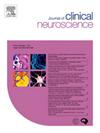丘脑下核与内白球脑深部刺激治疗肌张力障碍:安全性和有效性的系统回顾和荟萃分析。
IF 1.9
4区 医学
Q3 CLINICAL NEUROLOGY
引用次数: 0
摘要
目的:本系统综述和荟萃分析旨在比较针对丘脑下核(STN)和内苍白球(GPI)的深部脑刺激(DBS)治疗肌张力障碍的疗效和安全性。方法:到2024年7月,在五个数据库中实施综合搜索策略,确定与肌张力障碍中STN-DBS和GPI-DBS相关的研究。入选标准包括随机对照试验(rct)和比较两种干预措施的观察性研究。两名独立审稿人进行了筛选和数据提取。随机对照试验采用rob2评估偏倚风险,队列研究采用纽卡斯尔-渥太华量表评估偏倚风险。统计分析采用Review Manager进行meta分析,采用I2检验和卡方检验评估异质性。进行亚组分析和敏感性分析。结果:纳入5项研究,共154例患者。STN-DBS和GPI-DBS在1个月、6个月和12个月时伯克-法恩-马斯登肌张力障碍评定量表(BFMDRS-M和BFMDRS-D)的运动和残疾评分无显著差异。STN-DBS对心理健康有显著改善(SMD = 0.43, 95% CI: [0.05, 0.8], P = 0.03)。STN-DBS在汉密尔顿焦虑评定量表(HAMA)上也有显著改善(SMD = -2.7, 95% CI: [-5.38, -0.02], P = 0.05)。汉密顿抑郁评定量表(HAMD)得分差异无统计学意义。结论:STN-DBS和GPI-DBS均可改善肌张力障碍患者的运动症状,其中STN-DBS可能带来更优越的心理健康益处。未来的研究应着眼于长期结果和区域有效性,并包括不同的人群以提高普遍性。本文章由计算机程序翻译,如有差异,请以英文原文为准。
Subthalamic nucleus versus globus pallidus internus deep brain stimulation in the treatment of dystonia: A systematic review and meta-analysis of safety and efficacy
Objective
This systematic review and meta-analysis aimed to compare the efficacy and safety of deep brain stimulation (DBS) targeting subthalamic nucleus (STN) versus the globus pallidus internus (GPI) in the treatment of dystonia.
Methods
A comprehensive search strategy was implemented up to July 2024, across five databases, identifying studies relevant to STN-DBS and GPI-DBS in dystonia. Eligibility criteria included randomized controlled trials (RCTs) and observational studies comparing the two interventions. Two independent reviewers conducted the screening and data extraction. The risk of bias was assessed using RoB-2 for RCTs and the Newcastle-Ottawa Scale for cohort studies. Statistical analysis involved meta-analysis using Review Manager, with heterogeneity assessed by I2 and Chi-square tests. Subgroup and sensitivity analyses were performed.
Results
Five studies, involving 154 patients, were included. No significant difference was found between STN-DBS and GPI-DBS in Burke-Fahn-Marsden Dystonia Rating Scale motor and disability (BFMDRS-M and BFMDRS-D) scores at 1 months, 6 and 12 months. STN-DBS showed significant improvement in mental health (SMD = 0.43, 95 % CI: [0.05, 0.8], P = 0.03). STN-DBS also showed significant improvement in Hamilton Anxiety Rating Scale (HAMA) (SMD = −2.7, 95 % CI: [-5.38, −0.02], P = 0.05). No significant difference was found in Hamilton Depression Rating Scale (HAMD) scores.
Conclusions
Both STN-DBS and GPI-DBS can improve motor symptoms in dystonia, with STN-DBS potentially resulting in more superior mental health benefits. Future research should address long-term outcomes, and regional effectiveness, and include diverse populations to enhance generalizability.
求助全文
通过发布文献求助,成功后即可免费获取论文全文。
去求助
来源期刊

Journal of Clinical Neuroscience
医学-临床神经学
CiteScore
4.50
自引率
0.00%
发文量
402
审稿时长
40 days
期刊介绍:
This International journal, Journal of Clinical Neuroscience, publishes articles on clinical neurosurgery and neurology and the related neurosciences such as neuro-pathology, neuro-radiology, neuro-ophthalmology and neuro-physiology.
The journal has a broad International perspective, and emphasises the advances occurring in Asia, the Pacific Rim region, Europe and North America. The Journal acts as a focus for publication of major clinical and laboratory research, as well as publishing solicited manuscripts on specific subjects from experts, case reports and other information of interest to clinicians working in the clinical neurosciences.
 求助内容:
求助内容: 应助结果提醒方式:
应助结果提醒方式:


